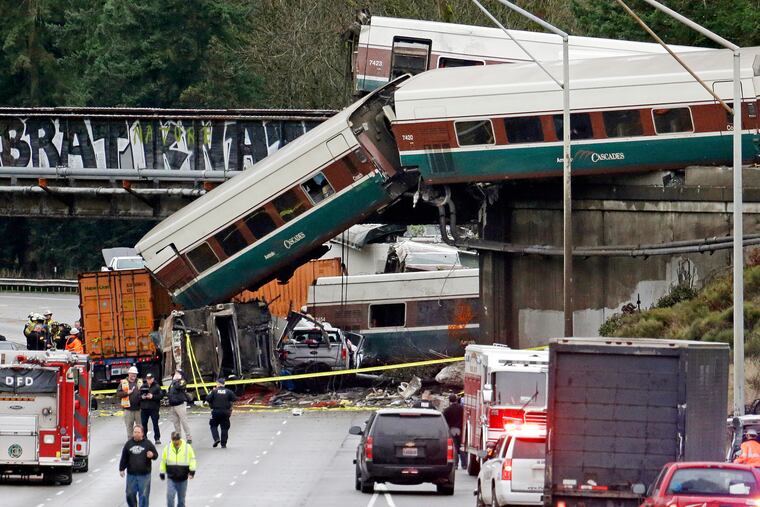Investigators: Human error caused deadly Amtrak crash near Seattle
Federal safety investigators are expected to present their findings on the Amtrak train derailment south of Seattle that killed three people and injured dozens

SEATTLE (AP) — A 2017 deadly Amtrak train derailment in Washington state happened because the engineer lost track of where he was on the route and was going more than twice the speed limit when he hit a curve, federal safety investigators said Tuesday.
The National Transportation Safety Board announced the findings at a meeting in Washington, D.C.
The train derailed Dec. 18, 2017, near DuPont, killing three and injuring dozens. The derailment occurred on the train's first paid passenger trip on a new route from Tacoma, Washington, to Portland, Oregon.
The News Tribune reports investigators also blamed the transit agency Sound Transit for not sufficiently mitigating the danger of the sharp bend, Amtrak for not better training the engineer, Washington State Department of Transportation for not ensuring the route was safe before green-lighting a passenger train and the Federal Railroad Administration for using rail cars beneath regulatory standards.
"The engineer was set up to fail," said NTSB Chairman Robert Sumwalt.
Although federal officials released preliminary findings after the crash, this is the first time investigators have offered a final determination of what happened.
Investigators said the train was going 78 mph (126 kph) when it rounded the curve. That's 48 mph (77 kph) faster than the 30 mph (48 kph) speed limit.
The engineer appeared to apply the brakes but did not put the brakes in emergency mode.
He told federal officials he was aware of the sharp curve — he'd operated the locomotive three times on that track and observed the route another 7-10 times — but lost track of where the train was on the route.
Seattle-based Sound Transit issued a statement Tuesday afternoon, calling the derailment "a terrible tragedy that sears in the memory of all of us at Sound Transit."
"While Sound Transit does not operate any service in the segment of track where the accident took place, as owner of the track we commit to closely reviewing the NTSB's report and implementing recommendations in collaboration with Amtrak, the Washington State Department of Transportation, BNSF and the Federal Railroad Administration," the agency said.
Amtrak also issued a statement Tuesday.
"We remain deeply saddened by the loss of life and injuries due to this tragic event," Amtrak said. It said it has already implemented a number of changes, including the creation of a new "safety organization" and the development of a strategic plan to "maximize the effective use of simulators in training, qualification and certification of Amtrak employees.
___
Information from: KIRO-TV, htthttp://www.kirotv.com/index.html